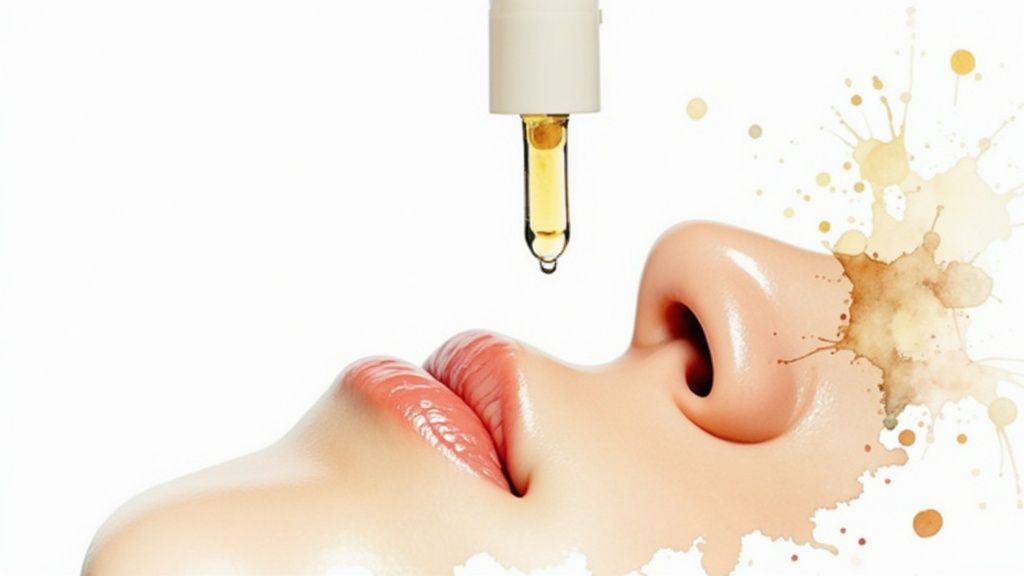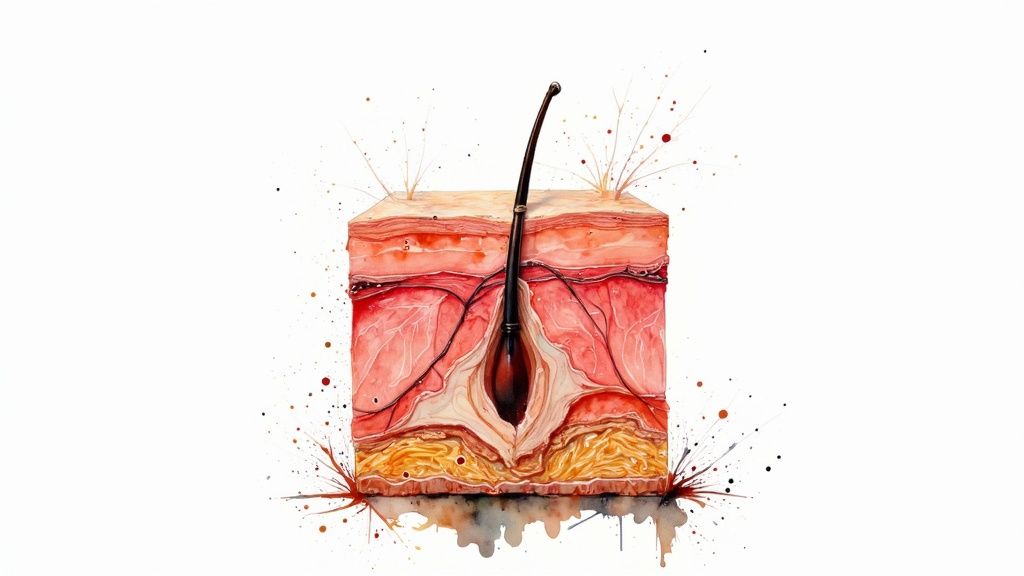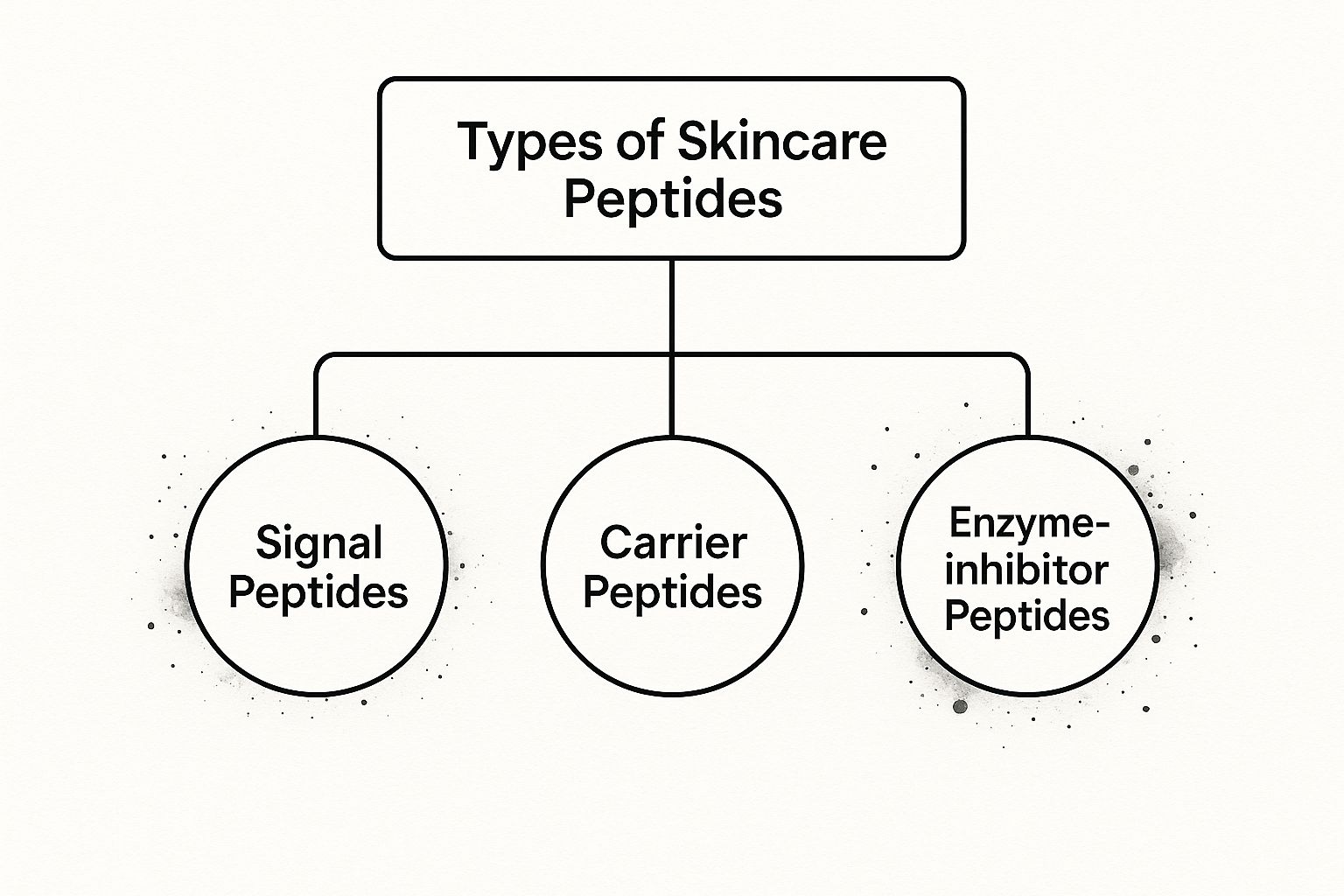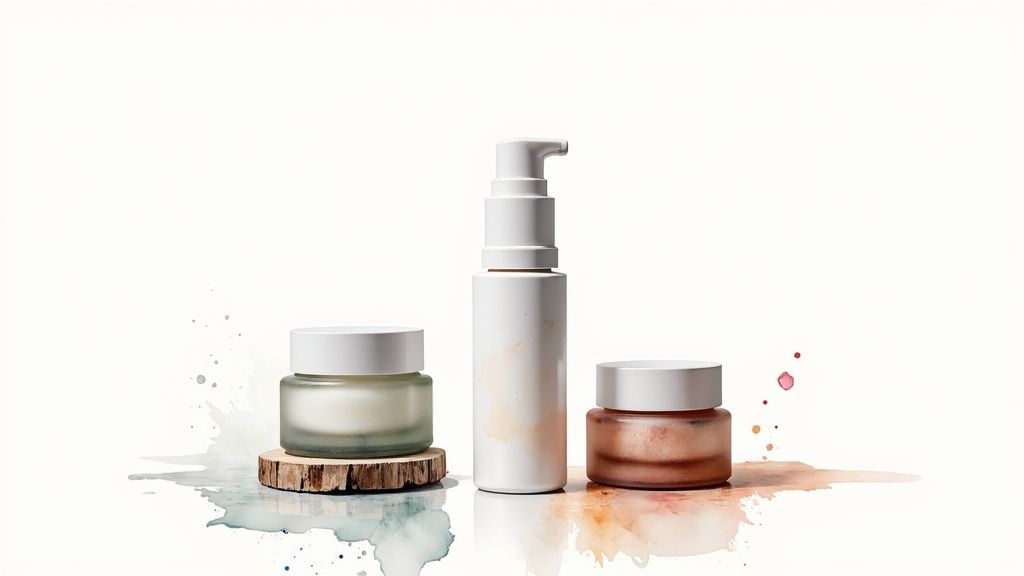
What Are Peptides In Skincare Explained Simply
Peptides are, at their core, short strings of amino acids. These amino acids are the very fundamental building blocks of proteins—crucial stuff like the collagen and elastin that give our skin its structure and bounce.
Think of peptides as tiny, highly specific messengers. They carry signals to your skin cells, telling them to perform certain jobs, like ramping up collagen production to keep your skin firm and youthful.
What Are Peptides? A Simple Analogy For Your Skin

Let's ditch the science-speak for a minute and use a simple analogy. Picture your skin as a busy construction site. The main material being used is collagen—it's the steel framework that keeps the whole structure strong, smooth, and resilient. When you're young, this construction site is a model of efficiency, with workers (your skin cells) constantly making repairs and reinforcing everything.
But as we get older, things start to slow down on site. The workers aren't as active, communication isn't as sharp, and that all-important collagen framework begins to weaken. This is when we start seeing the tell-tale signs of aging, like fine lines, wrinkles, and sagging skin. This is exactly where peptides step in.
The Role of Peptides as Messengers
Peptides are like the specialized foremen who show up on the job site with a fresh set of blueprints. They aren't going to mix the concrete or lift the steel beams themselves. Instead, their job is to deliver precise instructions to the cellular workers, telling them exactly what needs to be done.
These powerful messengers essentially tell your skin to fire up its own natural, youth-preserving functions. They remind your cells how they're supposed to behave—how they behaved when they were younger—and kickstart the production of those essential proteins.
This signaling ability is what makes peptides so incredibly effective in skincare. They get to the root of age-related changes by reigniting your skin's own ability to rebuild and repair itself from within.
From Amino Acids to Active Signals
So, how are these little messengers built? It all starts with amino acids, which are the basic units that create every protein in your body. Here’s a simple breakdown:
- Amino Acids: Think of these as the individual letters of the skincare alphabet.
- Peptides: When you link these letters into short "words" (chains of two to 50 amino acids), you get a peptide.
- Proteins: When you combine these words into long, complex "sentences" (chains of more than 50 amino acids), you create proteins like collagen and elastin.
Because peptides are small molecules, they can actually penetrate the skin's surface much more easily than a large protein like collagen can. Once they're in, they get to work communicating directly with your cells. Different combinations of amino acids create different peptides, and each one carries a unique message. Some tell your skin to build more collagen, while others might signal it to lock in hydration or calm down inflammation. It's this versatility that makes them such an indispensable tool in any skincare arsenal.
How Peptides Actually Work To Rebuild Your Skin

To really get why peptides are such a big deal in skincare, we need to peek under the hood at what our skin is doing over the years. When we're young, our bodies are practically peptide factories, constantly sending out tiny protein fragments that act as messengers. These messengers tell our skin to keep churning out the good stuff—collagen and elastin—which is what gives it that firm, bouncy feel.
But as the years go by, that internal assembly line starts to slow down. A lot. This slowdown is one of the main culprits behind fine lines, wrinkles, and that feeling that your skin just isn't as "snappy" as it used to be. Your skin cells haven't forgotten how to work; they just aren't getting the instructions as often or as clearly anymore.
The Science Of Cell Signaling
This is where smart skincare steps in. When you smooth a peptide-packed serum onto your face, you're essentially slipping those missing instructions directly back into the system. Peptides are small enough to get past the skin's outer security guard—the stratum corneum—something that larger molecules, like whole collagen, simply can't do.
Once they’re in, these peptides kick off a process called cell signaling. They act like a key fitting into a specific lock on your skin cells, especially the all-important cells called fibroblasts.
Think of fibroblasts as your skin's little collagen-making factories. Peptides are the new work orders arriving on the factory floor, telling the crew to fire up the machinery and start building a stronger, healthier skin structure again.
This direct line of communication is what makes peptides so powerful. They don’t just sit on the surface; they get in there and interact with your cells to trigger a genuine biological response. It's a clear cause-and-effect relationship: you apply the peptides, and your skin gets the memo to start acting younger.
Boosting Your Natural Collagen Factories
The result? Your skin's "factories" get busy producing more of those crucial structural proteins. By telling fibroblasts to make more collagen, peptides help rebuild your skin’s foundation from the inside out, leading to a whole cascade of visible improvements. For those interested in taking this even further, you can learn more about how to boost your natural collagen production in our detailed guide.
And this isn't just a temporary patch. When you use peptides consistently, you're encouraging your skin to maintain this higher level of protein production, which leads to lasting changes in firmness, texture, and overall health.
This isn't just industry hype, either. The global market for cosmetic peptide synthesis is expected to hit around US$ 331.3 million by 2032, and major brands are seeing a 55% jump in consumer interest for peptide-based products. People are catching on that these ingredients deliver real, science-backed results.
Why Topical Application Is Key
Putting peptides directly onto your skin is the most efficient way to get them exactly where they need to go. This targeted delivery system is far more effective than just hoping your body produces enough on its own, especially as we age.
Here’s what that targeted delivery does for your skin:
- Improved Firmness: By waking up collagen production, peptides help restore the skin's underlying support system, making it feel tighter and more resilient.
- Reduced Wrinkles: As that new collagen starts to plump up the dermal matrix, it effectively fills in and softens the look of fine lines and even deeper-set wrinkles.
- Enhanced Skin Barrier: Certain peptides also play a role in strengthening the skin's natural barrier, which means better hydration and more protection from environmental damage.
At the end of the day, peptides work by cleverly using your skin’s own communication network to its advantage. By sending in these "messenger" reinforcements, you empower your skin to get back to the business of repairing and rebuilding itself for a smoother, healthier, and more radiant look.
A Guide To The Main Types Of Skincare Peptides
Just like a construction site has different specialists—plumbers, electricians, and framers—the world of skincare peptides isn’t a one-size-fits-all category. Different peptides have highly specialized jobs. Understanding these key categories is the secret to decoding ingredient lists and choosing a product that targets your specific concerns with precision.
You wouldn't hire an electrician to fix a leaky pipe, right? Likewise, knowing which type of peptide you need is crucial for getting the results you want, whether that’s smoothing wrinkles, firming skin, or improving overall resilience. Let's break down the four main crews of peptides you'll find on the job.
Signal Peptides: The Collagen Commanders
Signal peptides are probably the most famous type in anti-aging skincare, and for good reason. They are the ultimate project managers for your skin. Their main job is to send direct messages to your fibroblasts—those cellular factories we talked about earlier—telling them to ramp up production of collagen, elastin, and other key proteins that make up your skin’s foundation.
When you apply a serum with signal peptides, you're essentially delivering a work order that says, "We need more structural support here!" This direct command helps counteract the natural slowdown in collagen production that comes with age. By kicking this protein-building process into high gear, signal peptides are fantastic for improving skin firmness, boosting elasticity, and softening the look of fine lines and wrinkles.
Common examples you’ll see on an ingredient list include anything with "Palmitoyl" in the name, like Palmitoyl Tripeptide-1, Palmitoyl Tetrapeptide-7 (often found together as Matrixyl 3000), and Palmitoyl Pentapeptide-4.
This handy guide breaks down the main peptide groups and what they do.
As you can see, each group approaches skin health from a different angle, from building new structures to protecting the ones you already have.
Carrier Peptides: The Mineral Delivery Service
Next up, we have carrier peptides. True to their name, these guys act like a specialized delivery service. Their main function is to grab onto essential trace minerals, like copper and manganese, and transport them to skin cells where they’re needed for all sorts of enzymatic processes.
Copper, in particular, is a superstar for collagen synthesis and wound healing. The problem is, it can be unstable on its own. Carrier peptides solve this by binding with these minerals, making sure they arrive safely at their destination to support skin repair, boost antioxidant activity, and encourage a firmer, smoother complexion. They are especially great for helping skin heal and dialing down inflammation.
The most famous of this group are copper peptides, often listed as Copper Tripeptide-1 or GHK-Cu. They're celebrated for their regenerative properties, which can help improve skin clarity and texture while promoting a healthier skin barrier.
Neurotransmitter Peptides: The Muscle Relaxers
You may have heard these called "Botox in a bottle," and that nickname gives you a pretty good idea of what they do. Neurotransmitter-inhibiting peptides have a fascinating job: they work by gently interrupting the communication between nerves and facial muscles. By subtly blocking the signals that tell your muscles to contract, they help soften the repetitive movements that etch expression lines into your skin.
Don't worry, this doesn't freeze your face the way an injection does. Instead, it just temporarily relaxes the muscle tension, making dynamic wrinkles—like crow's feet, forehead furrows, and the "11s" between the brows—appear smoother and less noticeable over time. This makes them a fantastic, non-invasive option for anyone looking to target expression-related aging.
Well-known examples you might see include:
- Acetyl Hexapeptide-8 (Argireline)
- Pentapeptide-18
- Dipeptide Diaminobutyroyl Benzylamide Diacetate (SYN-AKE)
Enzyme Inhibitor Peptides: The Collagen Protectors
Last but not least are the enzyme inhibitor peptides—the security guards for your skin. While signal peptides are busy building new collagen, these peptides are focused on protecting the collagen you already have. They work by slowing down the activity of enzymes, like matrix metalloproteinases (MMPs), that naturally break down proteins in the skin.
These collagen-munching enzymes get more active with age and sun exposure. By running interference and blocking their destructive work, these peptides help preserve your skin's existing firmness and bounce for longer. Think of them as a great defensive strategy in any anti-aging routine. Look for peptides from natural sources like Soybean Peptides or Trifluoroacetyl Tripeptide-2 to get this protective benefit.
To make it even easier to tell these powerful ingredients apart, here's a quick cheat sheet. This table breaks down what each peptide type does and what to look for on the label.
A Guide to Common Skincare Peptides and Their Functions
| Peptide Type | Primary Function | Best For Targeting | Common Ingredient Names |
|---|---|---|---|
| Signal Peptides | "Tells" skin to produce more collagen & elastin | Fine lines, wrinkles, loss of firmness | Palmitoyl Tripeptide-1, Palmitoyl Pentapeptide-4 (Matrixyl), Palmitoyl Tetrapeptide-7 |
| Carrier Peptides | Delivers trace minerals to support skin processes | Redness, wound healing, uneven texture | Copper Tripeptide-1 (GHK-Cu) |
| Neurotransmitter Peptides | Softens expression lines by relaxing facial muscles | Dynamic wrinkles (crow's feet, forehead lines) | Acetyl Hexapeptide-8 (Argireline), Pentapeptide-18 |
| Enzyme Inhibitor Peptides | Protects existing collagen from breaking down | Sagging, loss of elasticity, preventative aging | Soybean Peptides, Trifluoroacetyl Tripeptide-2 |
Understanding these roles helps you become a smarter shopper and allows you to pick products with the right "team" of peptides to tackle your specific skin goals effectively.
So, What Do Peptides Actually Do For Your Skin?

It’s one thing to understand the science, but what does it all look like in the mirror? Let's move beyond the lab. The real magic of peptides is in the tangible, visible changes they can make to your skin’s health and appearance.
When you bring peptides into your daily routine, you're essentially giving your skin the building blocks and instructions it needs to function at its best. The results aren't just superficial—they come from genuine improvements happening deep within the skin.
Let’s get into the key benefits you can actually expect to see.
You'll Notice Fewer Fine Lines And Wrinkles
This is what peptides are famous for, and for good reason. It all comes back to their ability to communicate with your skin cells.
Signal peptides, for instance, directly tell your skin's fibroblast cells to get busy making more collagen. As this new collagen network builds up, it adds support and volume from the inside out, effectively "plumping up" the areas where wrinkles have started to form.
Meanwhile, neurotransmitter peptides like Argireline work on a different angle. They help soften the repetitive muscle movements that etch expression lines into your forehead and around your eyes. Over time, the combined effect is a noticeably smoother, more refreshed complexion.
Your Skin Will Feel Firmer And Bouncier
That loss of firmness we all notice as we age? It’s a direct result of our collagen and elastin fibers breaking down. Peptides tackle this problem head-on by stimulating the production of these exact proteins.
This helps rebuild and reinforce your skin’s underlying support system. The result is skin that feels tighter and more resilient—it gets that youthful "snap" back. Carrier peptides also pitch in by delivering crucial minerals like copper, which are essential for creating strong, healthy collagen.
By getting to the root cause of sagging—the decline of structural proteins—peptides offer a powerful way to maintain a firm, sculpted appearance. This is a core reason they are so fundamental in effective anti-aging facial treatments.
The demand for these science-backed results is booming. The global market for anti-aging peptide skincare was valued at around USD 3.4 billion in 2024 and is expected to more than double to USD 7.2 billion by 2033. This incredible growth is driven by people seeking out ingredients that deliver real, measurable improvements. You can read more about the growth of the peptide market at Verified Market Reports.
Expect A Stronger, Healthier Skin Barrier
Think of your skin barrier as your personal bodyguard, protecting you from pollution, bacteria, and UV damage. When it’s weak, your skin becomes sensitive, dehydrated, and easily irritated. Peptides are fantastic for reinforcing this critical line of defense.
They encourage the synthesis of key proteins and lipids that seal up the cracks in your barrier. A stronger barrier means your skin gets much better at:
- Holding onto moisture, leading to better hydration and a plumper look.
- Fending off irritants, which means less redness and sensitivity.
- Healing itself, speeding up recovery from damage or inflammation.
This barrier-boosting power makes peptides a must-have for basically all skin types, but especially for anyone with sensitive or compromised skin.
Enjoy Calmer Skin And A More Even Tone
On top of their structural work, some peptides have impressive anti-inflammatory abilities. They can help soothe irritation and dial down redness, which is a game-changer for conditions like rosacea or for skin recovering from a breakout.
By calming this inflammation, peptides help create a more balanced and even complexion. They also support the skin's repair processes, helping to fade those stubborn post-inflammatory marks left behind by blemishes. This calming action is invaluable for achieving clear, uniform skin.
To really maximize these benefits, you can explore professional treatments. Learn more in our guide to customized anti-aging facial treatments.
How to Choose and Use Peptide Products for the Best Results
Alright, now that we’ve covered what peptides are and what they do, let's get to the fun part: putting them to work in your skincare routine. I know that navigating the world of skincare can feel like a lot, but picking the right peptide product is actually pretty simple once you know the ground rules.
Think of it like this: you wouldn't use a tiny screwdriver to hammer a nail. You need the right tool and the right technique for the job. It’s the exact same idea here. Let's break down how to choose a genuinely effective peptide product and use it correctly to get the results you’re paying for.
Look for Serums and Read the Label
Not all skincare products are created equal, especially when it comes to delivering active ingredients like peptides. You might see peptides listed in face washes or rinse-off masks, but honestly, those are mostly a waste of money. The product gets washed down the drain before the peptides have a chance to sink in and do their signaling work.
For real impact, you need products that stay on your skin for hours. Think serums, moisturizers, and eye creams. Serums are often the most effective choice because they’re lightweight, highly concentrated, and designed to absorb deep into the skin.
When you have a product in your hand, flip it over and scan the ingredient list. You want to see the actual peptide names—like Palmitoyl Tripeptide-1 or Acetyl Hexapeptide-8—listed somewhere near the top. If they’re hiding at the very bottom of a long list, the concentration is probably too low to make a noticeable difference.
Create Smart Ingredient Pairings
Peptides are fantastic team players. They work even better when you pair them with other powerhouse ingredients, creating a combination that can tackle multiple skin concerns at once.
Here are a few of my favorite power couples:
- Peptides + Hyaluronic Acid: This is the ultimate firm-and-plump duo. Hyaluronic acid is a moisture magnet, pulling water into the skin for a dewy, hydrated look. This beautifully complements the firming and rebuilding work of the peptides.
- Peptides + Niacinamide: Think of this as your skin's defense and repair crew. Niacinamide (Vitamin B3) is a master at strengthening the skin barrier, calming redness, and smoothing texture. When paired with peptides, you get a robust system that both protects and rebuilds.
- Peptides + Antioxidants (like Vitamin C): This is a classic day-and-night strategy. Antioxidants protect your skin from environmental stress during the day, while peptides focus on repair and regeneration. Using a Vitamin C serum in the morning and your peptide serum at night is a brilliant approach to 24/7 skin health.
One quick note: be a little cautious about using your peptides at the exact same time as strong direct acids, like AHAs and BHAs. It’s not always a problem, but high concentrations of acids can sometimes mess with the stability of certain peptides. To be safe, just use them at different times—maybe your acid exfoliant at night and your peptide serum in the morning, or on alternate nights.
Where Peptides Fit in Your Daily Routine
Getting your product layering right is key. You want to make sure every product can do its job without anything getting in its way. The golden rule is simple: apply products from the thinnest to the thickest consistency. Peptides need to get as close to your skin cells as possible to deliver their messages effectively.
Here’s a simple, step-by-step guide for placement:
- Cleanse: Always, always start with a clean face. You need to clear away any dirt, oil, or makeup first.
- Tone (Optional): If you use a hydrating toner or essence, apply it now while your skin is still slightly damp.
- Apply Your Peptide Serum: This is the star of the show. Squeeze out a pea-sized amount and gently press it into your skin. This helps it absorb deeply before you add anything heavier on top.
- Apply Other Serums: If you’re using other treatments (like a hyaluronic acid serum), layer them on now.
- Moisturize: Use your favorite moisturizer to seal in all the goodness and keep your skin hydrated.
- Sunscreen (AM): In the morning, this is the non-negotiable final step. Sunscreen protects your skin and all the new, healthy collagen that your peptides are working so hard to help you build.
Consistency is the non-negotiable key to success with peptides. Think of it as a fitness routine for your skin. One great workout won't transform your body, and one application of a peptide serum won't erase wrinkles. You need to provide those cellular signals consistently, morning and night, to see real, lasting change.
The science and manufacturing behind these tiny powerhouses are complex, which is reflected in their price. The cosmetic peptide manufacturing market was valued at about USD 257.4 million in 2025 and is expected to grow to USD 434.1 million by 2035, all thanks to our growing demand for effective, science-backed skincare. The intricate process of creating and stabilizing these molecules is why good peptide products are an investment in your skin's future. You can read more about the cosmetic peptide manufacturing market at Future Market Insights. For expertly formulated options, feel free to explore our curated list of professional-grade skincare products.
Got Questions About Peptides? Let's Talk.
Even after diving into the science, it's totally normal to have a few practical questions. Think of this as the part of our chat where we clear up any lingering doubts before you dive in. We'll tackle the most common questions and myths so you can feel 100% confident about adding peptides to your skincare lineup.
My goal is to give you clear, no-fluff answers. Let's get into the nitty-gritty so you know exactly what to expect and how to make these fantastic little communicators work for you.
How Long Does It Really Take To See Results?
This is always the first question, and the honest answer is: it's a marathon, not a sprint. While you might feel some nice, immediate plumping or hydration (which is a great bonus!), the real work of peptides—like rebuilding collagen to smooth out fine lines—happens on a deeper level. And that takes time.
Most people start to see noticeable, lasting changes within 4 to 12 weeks of consistent use. You have to be diligent, applying them morning and night. Think of it like going to the gym; you don't build muscle after one workout. You're giving your skin a set of instructions, and it needs to receive that message over and over to create real change.
Stick with it! The payoff for your patience is cumulative. Consistent application is what makes those cellular signals stick, leading to skin that’s genuinely firmer and smoother over time.
Can I Use Peptides With My Vitamin C And Retinol?
Yes, you absolutely can! This is a smart question because how you layer your products makes all the difference. Peptides are fantastic team players; they get along with most other active ingredients and can even make them work a little better.
Here’s a simple way to fit them into your routine:
- In the Morning: Go ahead and layer your peptide serum with your Vitamin C. A good rule of thumb is to apply the product with the thinnest texture first. This power couple gives you both repair signals and a strong antioxidant shield for the day.
- At Night: Apply your peptide product, give it a minute to sink in, and then follow up with your retinol. This lets the peptides get to work on repair and recovery before the retinol comes in to accelerate cell turnover.
The one major exception here is copper peptides. You'll want to avoid using them in the same routine as Vitamin C. There's some chatter in the industry that they can cancel each other out, so it's safer to use one in the morning and the other at night.
Are Peptides Safe For My Sensitive Skin?
Yes, and this is one of the best things about them. Peptides are known for being incredibly gentle and are well-tolerated by just about every skin type out there, including sensitive, reactive, and even acne-prone skin.
Because peptides are just short chains of amino acids—the very building blocks your body already uses—the risk of irritation is incredibly low, especially when compared to high-strength acids or retinoids. In fact, many peptides have calming, anti-inflammatory properties that can help soothe irritated skin and strengthen a weak barrier, making them a fantastic choice for anyone dealing with sensitivity.
But Do Peptides Actually Get Into The Skin?
This is a brilliant and crucial question. After all, an ingredient is useless if it just sits on the surface.
The short answer is yes, a well-formulated peptide can. The amino acid chains are small enough to make their way past the skin's outer defenses. But what's even more important is how modern skincare products give them a helping hand. Formulators use sophisticated delivery systems to make sure these molecules get to where they need to go.
These systems might include:
- Carrier Peptides: As we talked about earlier, some peptides have the specific job of piggy-backing other ingredients deeper into the skin.
- Liposomes: Think of these as tiny delivery bubbles. They encapsulate the peptides, protecting them as they travel through the skin's outer layer to reach their target cells.
So, when you invest in a quality peptide product, you can trust that those intelligent messengers are actually getting to work, rebuilding and rejuvenating your skin from the inside out.
At Olive Skin Therapy, we're all about using clinically-proven ingredients to get you real, visible results. Our customized facial treatments are built to harness the power of ingredients like peptides for your unique skin. Book a personalized consultation to see how we can build a routine that leads to your healthiest, most radiant skin yet.
